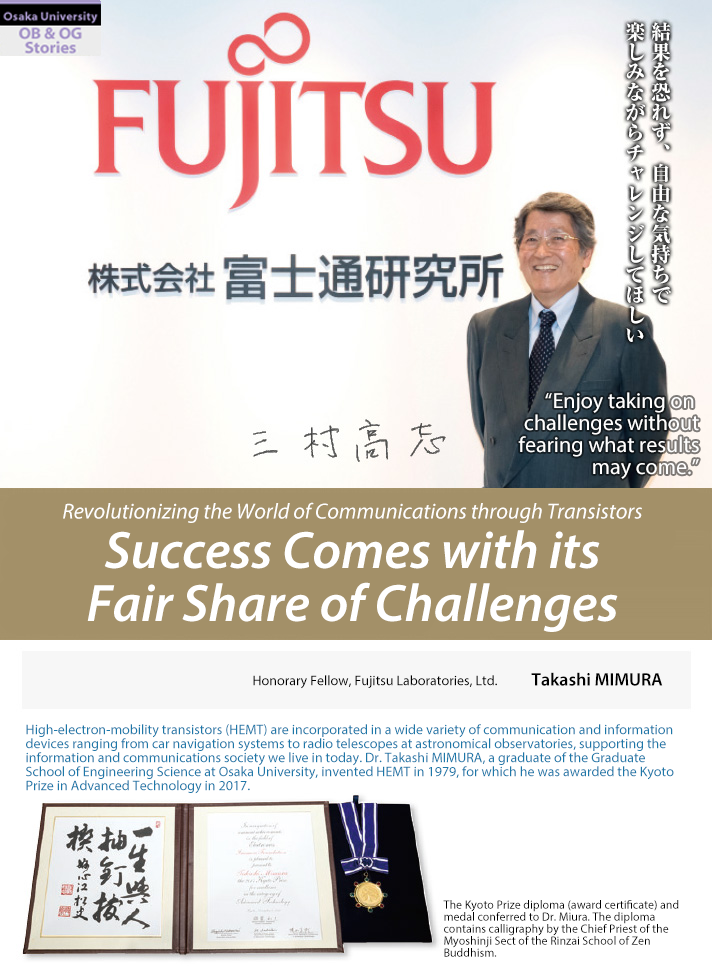
Takashi MIMURA (Honorary Fellow, Fujitsu Laboratories, Ltd.)
He learned
theories and fundamentals,
which can be utilized in manufacturing, during his graduate studies at OU
 After graduating from the School of Science at Kwansei Gakuin University, Dr. Mimura entered the Graduate School of Engineering Science at Osaka University. He chose the graduate school
After graduating from the School of Science at Kwansei Gakuin University, Dr. Mimura entered the Graduate School of Engineering Science at Osaka University. He chose the graduate school
because he wanted to
engage in research by which he could develop theories and contribute to society. “There were both science and engineering professors at the graduate school, so they stimulated me in terms of theory and practice.”
"As a student, I often slept in the lab,” laughed Dr. Mimura. At the time, experimental equipment was not readily available, so we
had to wait for a long time to use the measurement devices.
“I often waited until midnight for my turn.”
On the other hand, “The things I learned at the graduate school were fundamentals that could be applied to any form of manufacturing.” Said a passionate Dr. Mimura, “Fundamentals are
sort of like a trunk of a tree, something that is very important. If you are
well-grounded, you can sprout branches and leaves from there.”
Forming a team with his Engineering Science Companions
He entered Fujitsu and was assigned to the research and development division for semiconductor-based high-performance transistors.
However, he had a difficult time yielding results. To put his research behind him, in 1979, he published a paper on gallium arsenide (AlGaAs) transistors that he had been working on for two years.
After the publication, while chatting with other researchers, he had the idea of a high-electron-mobility transistor (HEMT), in which free electrons in the aluminum gallium arsenide (AlGaAs) layer are transferred to the gallium arsenide (GaAs) layer, enabling high-speed processing.
“Although my previous research was certainly a failure, I believe that success
was bred from this failure.”
Immediately summarizing the idea of HEMT, Dr. Mimura called out for like-minded individuals within the company. This was the start of the company’s unofficial “Underground Research Team.” In HEMT development, a molecular beam epitaxy (MBE) is required to form the
conjunction between the gallium arsenide (GaAs) and the aluminum gallium arsenide (AlGaAs). So, Dr. Mimura approached the MBE Group at Fujitsu as to their interest in HEMT.
Satoshi HIYAMIZU, an alumnus of the Graduate School of Engineering
Science at OU, responded to his expectations.
“At our meeting, I learned that he was a year ahead of me in university.
Because we had studied at the same graduate
school, our communication went very smoothly.”
Their efforts bore fruit as the first prototype at the end of that very same year. “We were able to return the favor to Dr. Hiyamizu’s MBE Group, which had worked hard with us.” Dr. Hiyamizu later became a professor at the Graduate School of Engineering Science at OU. Some of his students have undergone training at the Fujitsu Laboratories and are now active both in Japan and overseas. “I’m happy to see the next generation of OU students starting to become active.”

Expanding global networks of HEMT researchers

First, HEMT was used in radio telescopes, but Dr. Mimura and
his group made efforts to realize mass production and lower production costs,
achieving sales for one ten-thousandth of the original price. As a result, HEMT technology is now used in car radars to automatically provide braking assist, as well as in
wireless telephone base stations, and applied and materials research on HEMT is being conducted all around the world. Dr. Mimura found future possibilities from his failure. He encouraged current students, saying, “Don’t be afraid of failure.”
• Takashi MIMURA
A 1970 graduate of the Graduate School of Engineering, Osaka University, Dr. Mimura received his doctorate in Engineering in 1982. He began at Fujitsu in 1970, moved to Fujitsu Laboratories Ltd. in 1975, and became a Fellow at Fujitsu Laboratories in 1998 and an Honorary Fellow in 2017. In 2006, he became a visiting researcher at the National Institute of Information and Communications Technology (NICT). Some awards Dr. Mimura has received include the 1990 IEEE Morris N. Liebmann Memorial Award, the 1998 Medal with Purple Ribbon, and the 2017 Kyoto Prize in Advanced Technology.
Corporate Information
Fujitsu Laboratories, Ltd. (4-1-1 Kamikodanaka, Nakahara-ku, Kawasaki, Kanagawa)

Fujitsu Laboratories is a primary subsidiary of Fujitsu Limited, which is the core of research and development in the Fujitsu Group.
Established in 1962 within Fujitsu, the company performs a wide range of research and development, from research and development of materials, next-generation devices, computers, networks, and ICT systems, to creating next-generation solutions, services and business models to solve current and future challenges in society through advanced technology.
Note: This is a reprint of the article posted in the Osaka University NewsLetter No. 78 (February 2018).